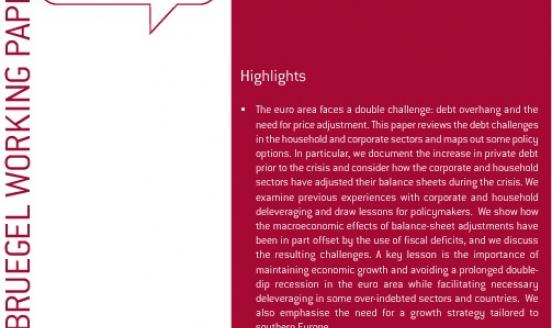Good deal for Ireland, but no magic bullet
The promissory note deal announced last week by the Irish government and the Central Bank of Ireland will bring benefits to Ireland’s public finances
The promissory note deal announced last week by the Irish government and the Central Bank of Ireland will bring benefits to Ireland’s public finances and to the country’s financial stability. As a result, Ireland’s prospects for economic recovery and its chances of emerging from its EU/IMF programme of financial assistance have improved markedly. Indeed, yields on long-term Irish government bonds are now well below those of Italy and Spain.
Nonetheless, Ireland’s economic recovery remains fragile, with large debt overhangs in the public and private sectors as well as poor prospects for growth in its major trading partners.
Background
Ireland’s two worst banks, Anglo Irish Bank and Irish Nationwide Building Society, were merged in March 2011 to form the Irish Bank Resolution Corporation (IBRC). This entity was almost entirely funded by Exceptional Liquidity Assistance (ELA) of €40bn extended by the Central Bank of Ireland.
The Central Bank of Ireland advanced these monies to IBRC against two main types of collateral: €25bn worth of a promissory note issued by the Irish government to recapitalise Anglo and €15bn of loan assets. The promissory note was scheduled to amortise at a rate of about €3bn per year – a process that would provide funds to IBRC to gradually pay down the ELA.
Liquidation and swap deal
Last week, IBRC was put into liquidation. The Central Bank of Ireland was then entitled to demand full repayment of ELA, which in effect meant taking ownership of the collateral securing these loans.
What will the Central Bank do with these assets?
· As the Central Bank of Ireland has no business in managing a commercial loan book, the €15bn in loans will be sold promptly to NAMA, Ireland’s “bad bank”, in exchange for NAMA bonds or to the market for the best possible price.
· The Central Bank will exchange the promissory note for newly issued long-term (25-40 year) Irish government bonds. The Central Bank will hold onto these bonds until such time as the selling of these bonds into the market will not constitute any risk to financial stability. Notwithstanding this condition, the Central Bank has agreed with the ECB a schedule of minimum disposals.
Benefits of the deal
The exchange of the promissory note for long-term bonds is mutually beneficial for both the Central Bank (and wider Eurosystem) and the Irish government. From the Central Bank’s perspective, a non-marketable, illiquid asset -- whose terms could arguably have been unilaterally changed by the Irish government without constituting a formal default – has been swapped for standard Irish sovereign bonds.
From the Irish government’s perspective, there are three main benefits from the exchange.
First, the interest payments on Irish sovereign bonds held by the Central Bank are essentially internal transfers between one part of the Irish state and another. Of course, this is also true for the interest payments on ELA paid by the state-owned IBRC to the Central Bank. Since the rate of disposal by the Central Bank of its holdings of bonds will very likely be considerably slower than the rate at which ELA was expected to be repaid, the government’s interest burden over the medium term has declined as a result of the exchange.
Second, under the promissory note arrangement, the Irish government would have needed to sell about €3bn of new bonds into the markets annually to raise funds to pay down the note. The bonds given to the Central Bank in exchange for the note will not need to be refinanced for 25-40 years. The resulting reduction in the supply of bonds to the market over coming years should mean lower interest rates on borrowings to finance the budget deficit and refinance maturing debt. Borrowing costs for Ireland’s banks are also likely to be lower. In addition, the refinancing risks to the State associated with ELA (which is subject to bi-monthly non-objection from the ECB) have been removed.
Finally, government accounting rules treated interest payments to IBRC on the promissory note as public spending. The lower interest rates on the sovereign bonds translate into a reduction in Ireland’s general government deficit next year of 0.6 per cent of GDP. As a result, assuming no change in planned fiscal consolidation efforts, Ireland’s budget deficit is now expected to narrow to 4.5 per cent of GDP in 2014.
Last week’s deal is by no means a magic bullet for Ireland’s economic and financial difficulties, but it is another step in the right direction.

